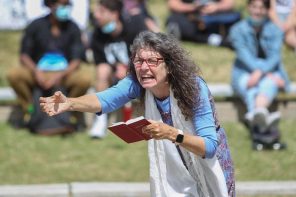“November 18, 1978.”
Whether documentary, article, or book, nearly all accounts of the tragedy of Jonestown, a doomed socio-agricultural commune in the jungle of Guyana, begin this way. After all, this was the moment of impact, the day on which nearly 1,000 members of the Peoples Temple died after ingesting a cyanide-laced fruit drink at the order of their leader, Jim Jones.
The fatalities weren’t confined to the 1200-acre complex, however; a few miles away, five people, including Congressman Leo Ryan of California and two NBC News employees, had been shot on a tarmac while waiting to shepherd defectors home to the United States. About 150 miles away, in the Peoples Temple office in Georgetown, the capital of Guyana, member Sharon Amos slit the throats of her three children and then killed herself. Though the world would not know the correct death toll until more than a week after the slaughter, the date of the horrifying happenings at Jonestown is the one emblazoned in our cultural consciousness. On November 18, 1978, the largest number of American civilian lives was lost due to a single non-natural disaster—a sad distinction Jonestown would hold until September 11, 2001.
In Stories from Jonestown, the most recent addition to the Jonestown library, Leigh Fondakowski has compiled the numerous interviews that she conducted in order to write her play, The People’s Temple, which ran at the Berkeley Repertory Theater from April 15 to June 5 of 2005. Fondakowski, best known for penning the highly regarded play-turned-HBO-movie The Laramie Project, told the New York Times that although she’d been hoping to avoid “dark, depressing subject matter” after writing about the murder of Matthew Shepard, she was drawn into the Jonestown vortex after David Dower of the Z Space Theater encouraged her to explore the tragedy.
Fondakowski and her creative team began the project in 2002 and spent the subsequent three years interviewing survivors of Jonestown, their families, politicians, journalists, investigators and others involved both directly and peripherally in Jonestown and its aftermath. The product is ambitious in scope, though its intent is unclear. Fondakowski and Co.’s only real agenda, she says, is to give a platform to those who believed their voices weren’t heard in the aftermath of the tragedy. In other words, she wants to “raise awareness,” that maddeningly vague and particularly modern goal.
But why raise awareness now, after all these years? And besides, who hasn’t heard of Jonestown? In the thirty-odd years since the tragedy, who hasn’t read an article or seen a documentary on the subject, which received a barrage of media coverage in 2008 for the 30th anniversary? Did all the previous attempts at memorialization fail? Of course, there are misconceptions about what actually occurred that day—the most egregious being that all the victims voluntarily drank the poison—but an attempt to separate fact from myth hardly seems like a movement that will gain much traction at this late date when we have so much else to deal with. As Jim Jones Jr., the adopted son of Jim and Marceline Jones, tells Ms. Fondakowski, “Just put your cap forward and keep moving.”
But perhaps the best way to understand this text is to view it as the story of a small group coming to grips with a mass cultural trauma. As a number of notable sociologists put forth in their book Cultural Trauma and Collective Identity (University of California Press, 2004), society, to put it simply, can experience trauma like an individual can. As with the individual, there are a few things that make a society more vulnerable to trauma.
“A society emerging from a major war, suffering from diminished economic resources, experiencing rampant internal conflict, or having shaky social solidarity,” as Professor Neil J. Smesler writes in his contribution to the volume, “is more trauma-prone than others that are more solid in these respects.”
Jonestown was, of course, an American cultural trauma, though it can be hard to conceive it as such given the more largely looming legacies of slavery, the Holocaust, and September 11th. In 1978, America was still reeling from the loss of the Vietnam War and struggling to regain trust in its government; the culture was transforming from an atmosphere of free love and pacifism into one of Technicolor consumerism. So while the Manson Family murders and the events at Altamont might have been blows to the hippie ethos of the ’60s, it was Jonestown, the utopian dream gone terribly, terribly wrong, that was its death knell.
One of the more poignant aspects of the trauma of Jonestown is that Jones and his followers held strong beliefs that today we recognize as commonplace. Whereas it can be easy to dismiss the Manson Family as a couple of deranged Beatles fans ruminating on inherently wacky apocalyptic fantasies, Peoples Temple began with the tenet of racial equality and a devotion to the apostolic idea of service and charity.
The early iteration of the Temple, based in Indianapolis in the 1950s, was completely integrated in a city that still resembled the Jim Crow South. Jones himself adopted numerous black and Korean children whom he referred to as his “rainbow family.” He also personally helped desegregate public buildings and institutions in Indianapolis, and when racial violence flared up he would walk through the badly hit neighborhoods to prevent white flight and counsel the victims of the attacks. His hands-on approach to fighting racism is reminiscent of a barefoot Gandhi taking up residence in an East Bengali village after fighting between Hindus and Muslims threatened to destroy the region. Of the many new religious movements of the 1960s and ’70s, Peoples Temple is probably the only one that can boast an agenda that remains enormously relevant to us today. That its genesis was admirable makes the implosion of the dream that much more tragic.
Following Fondakowski, who seems to know few details about Jonestown at the outset of the book, is to understand the way one person might confront and internalize a mass cultural trauma. We watch as she absorbs the overwhelming arc of the story, and then the heartbreaking individual narratives that underlie it; as she attempts to make sense of the seemingly senseless loss of life.
“What happened to this movement? What happened to the dream?”
We can feel the heartache as she listens to Stephan Jones, the poised son of the man many believe to have been a drug-addicted demagogue, explain how he lost his mother, his father, and all of his friends in one harrowing moment; sense her tentative thrill when Garry Lambrev, a former Temple Member, hints at the government’s conspiratorial role; and we watch her pore over these details again and again, and come, ultimately, to no conclusion.
This could be viewed as a journalistic or artistic failing on Fondakowski’s part, though in reality it is the only possible way for her story—and the story of Jonestown—to end. There won’t be closure here, because closing the book on a trauma of this magnitude might just be impossible. And perhaps the only possible way to digest the trauma is by obsessively remembering it. Freud first posited that the “compulsion to repeat” was the human being’s way of repressing trauma, though it was later seen as a natural, self-soothing response.
Smelser, in an interview with Harry Kreisler of the Institute of International Studies, posits that society also feels the repetition compulsion:
The idea [of mass cultural trauma] is that certain historical events are so profound in their cultural and personal impact that they develop the features that resemble psychological trauma, namely that they’re permanently unsettling, that you can’t forget about them, even if you try to forget about them, there’s a kind of compulsive need to relive and re-experience.
Consider this then in the wake of our most recent societal tragedy: the shooting spree at Sandy Hook elementary. When the news first broke, there was just the horror. After the initial media coverage, though, journalists began to shift their focus to the ancillary aspects of the event, the small narratives inside the larger one. The little girl wanted to wear her cowboy boots that day; the teacher shoved the children inside a bathroom and told them to be quiet; the crew of a JetBlue flight took a card for one victim from Seattle all the way to Newtown to lay it in his coffin because his cousin had made it for him.
As the coverage became less about piecing together the day’s events and more about the emotionally turbulent aftermath, the sense of public discomfort began to grow. Internet commenters chided writers for dwelling on the horrible and unnecessary details. Slideshows of pictures of the victims were decried as gauche and enabling an already-voyeuristic culture. Reporters still on site in Newtown were viewed as parasitic. Just go home already and leave these people to their grieving.
But a more generous view is that we needed to return to these petty details in order process the trauma and to grieve for the victims—and for ourselves. Though it sounds soppy in a secular age, we all lost those children, and we all in turn needed to confront this trauma in the only way we knew how: by repeating it on our websites, in our conversations, and in our minds.
Our cultural grief comes out this way partly because the Internet is how we communicate with each other about current events, and partly because we don’t have a lot of space in our world for such public displays of mourning. (In contrast, recall the brutal murder of Leiby Kletzky, in 2010, and the fact that thousands of Hasidic Jews, who have a ritualized response to grief, descended upon Borough Park for his funeral.) The process sometimes dredges up uneasy feelings—a rubbernecker’s shame reflex, a pang of guilt at infringing on the legitimate mourning of another—but in fact it’s a viable and legitimate way for our society to attempt to comfort ourselves in the wake of something traumatic.
So does this mean that the existence of Stories from Jonestown indicates that America has never fully recovered from the events of November 18, 1978? Yes and no. The most interesting thing about the book itself—an unremarkable contribution to the Jonestown canon—is the fact that it exists; that while the wound may not be as raw as it once was, we seem to have a great deal of media left to make.




